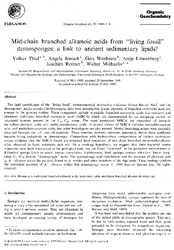Mid-chain branched alkanoic acids from "living fossil" demosponges: a link to ancient sedimentary lipids?
Zeitschrift: Organic geochemistry, 199930, 1: 1 - 14
Thiel, Volker; Jenisch, Angela; Wörheide, Gert; Löwenberg, Antje; Reitner, Joachim; Michaelis, Walter, 1999: Mid-chain branched alkanoic acids from "living fossil" demosponges: a link to ancient sedimentary lipids?. In: Thiel, Volker; Jenisch, Angela; Wörheide, Gert; Löwenberg, Antje; Reitner, Joachim; Michaelis, Walter (1999): Mid-chain branched alkanoic acids from "living fossil" demosponges: a link to ancient sedimentary lipids? - Organic geochemistry; Vol. 30, Nr. 1, p. 1-14, DOI: 10.23689/fidgeo-2448.
 |
Dokument öffnen: |
The lipid assemblages of the "living fossil" stromatoporoid Astrosclera willeyana (Great Barrier Reet) and the
demosponge Agelas aroides (Mediterranean Sea) were investigated. Large amounts of branched carboxylic acids are
present in the sponges studied. These compounds include terminally branched carboxylic acids (isa -/anteisa-) and
abundant mid-chain branched carboxylic acids (MBCA) wh ich are characterized by an intriguing variety of
structural isomers present in the C 15- C25 range. The most prominent MBCA are comprised of isomeric
methylhexadecanoic acids and methyloctadecanoic acids. A second cluster of MBCA includes methyldocosanoic
acids and methyltetracosanoic acids, but other homologues are also present. Methyl branching points were generally
observed between the w5- and w9-positions. These complex isomeric mixtures apparently derive from symbiotic
bacteria living exclusively in demosponges. Comparison with hydrocarbon compositions of ancient carbonates
reveals evidence that the MBCA found are potential lipid precursors of mid-chain branched monomethylalkanes
often observed in fossil sediments and oils. As a working hypo thesis, we suggest that their bacterial source
organisms have been widespread in the geological past, and are found " inherited" in the protective environment of
distinctive sponge hosts in recent marine ecosystems. Furthermore, both sponges contain abundant linear, longchain
C24- C26 dienoic "demospongic" acids. The demospongic acid distribution and the presence of phytanic acid
in A. willeyana match the patterns found in A. aroides and other members of the Agelasida. These findings confirm
the systematic position of A. willeyana within this demosponge taxon.

